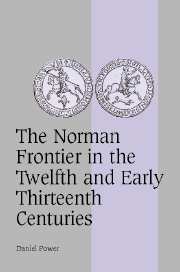Book contents
- Frontmatter
- Contents
- List of maps
- List of tables
- Preface
- Notes on names, dates, manuscripts and coinage
- Note on maps
- List of abbreviations
- Introduction
- Part I PRINCELY POWER AND THE NORMAN FRONTIER
- Part II THE POLITICAL COMMUNITIES OF THE NORMAN FRONTIER
- Part III THE POLITICAL DEVELOPMENT OF THE NORMAN FRONTIER
- Conclusion
- Appendix I Genealogies
- Appendix II The campaigns in eastern Normandy (1202)
- Bibliography
- Index
Conclusion
Published online by Cambridge University Press: 22 September 2009
- Frontmatter
- Contents
- List of maps
- List of tables
- Preface
- Notes on names, dates, manuscripts and coinage
- Note on maps
- List of abbreviations
- Introduction
- Part I PRINCELY POWER AND THE NORMAN FRONTIER
- Part II THE POLITICAL COMMUNITIES OF THE NORMAN FRONTIER
- Part III THE POLITICAL DEVELOPMENT OF THE NORMAN FRONTIER
- Conclusion
- Appendix I Genealogies
- Appendix II The campaigns in eastern Normandy (1202)
- Bibliography
- Index
Summary
The frontier of ducal Normandy has generally been depicted as unique. For its two greatest historians, Lemarignier and Musset, it was an ‘exceptionally clear-cut’ or ‘neatly separating’ division that contrasted with the more fluid or ill-defined borders of most contemporary principalities. Yet in most respects the marches of Normandy differed little in character from other borderlands of the central Middle Ages. Like the fringes of other principalities, they were characterised by competing aristocratic and princely interests and ill-defined or fragmented jurisdictions. The history of the Norman frontier reveals not its uniqueness, but its broad similarity to other frontier regions of Europe.
The Norman frontier did have some unusual aspects. For most of the twelfth century those boundaries of the duchy that were designated by rivers functioned quite effectively as the limits of ordinary ducal jurisdiction. This precision was especially notable in the north-east and south-east along stretches of the Bresle, Epte, Eure and Avre, in the south along the upper valley of the Sarthe, and in the south-west along the Couesnon. Where watercourses were deemed insufficient or had to be abandoned through political necessity, the dukes and their subjects fixed boundary-markers and dug extensive earthworks as alternative solutions.
- Type
- Chapter
- Information
- Publisher: Cambridge University PressPrint publication year: 2004



